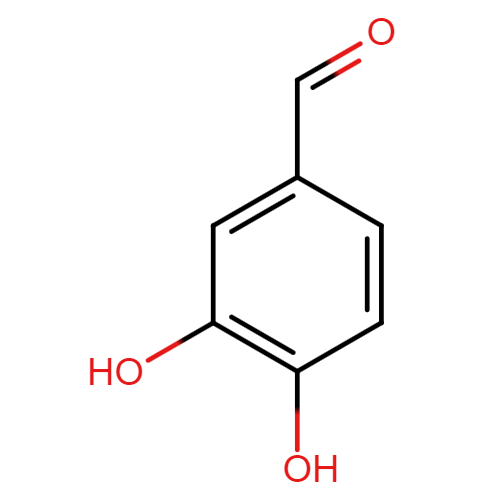Protocatechualdehyde
| Compound Structure: |

|
||||||||||||||||||||||||||||||||||||||||||
|---|---|---|---|---|---|---|---|---|---|---|---|---|---|---|---|---|---|---|---|---|---|---|---|---|---|---|---|---|---|---|---|---|---|---|---|---|---|---|---|---|---|---|---|
| Synonyms: | 3,4-Dihydroxybenzaldehyde;Protocatechualdehyde;139-85-5;PROTOCATECHUIC ALDEHYDE;Rancinamycin IV;Benzaldehyde, 3,4-dihydroxy-;4-Formyl-1,2-dihydroxybenzene;3,4-Dihydroxybenzenecarbonal | ||||||||||||||||||||||||||||||||||||||||||
| Compound ID: | NMPC-308 | ||||||||||||||||||||||||||||||||||||||||||
| PubChem ID: | |||||||||||||||||||||||||||||||||||||||||||
| Molecular Formula: | C7H6O3 | ||||||||||||||||||||||||||||||||||||||||||
| Canonical SMILES: | C1=CC(=C(C=C1C=O)O)O | ||||||||||||||||||||||||||||||||||||||||||
| InChIKey: | IBGBGRVKPALMCQ-UHFFFAOYSA-N | ||||||||||||||||||||||||||||||||||||||||||
| About the compound: | Protocatechuic aldehyde, also known as protocatechualdehyde or 3,4-dihydroxybenzaldehyde, is a phenolic aldehyde found in various natural sources, including barley, green cavendish bananas, grapevine leaves, and the root of the herb Salvia miltiorrhiza. It is also known to be released from cork stoppers into wine. This compound has been of interest for its potential health benefits and biological properties: Protocatechuic aldehyde can be used as a precursor in the synthesis of vanillin. This process often involves biotransformation using cell cultures of certain plants, such as Capsicum frutescens (Chili pepper). It is naturally found in several plant sources, making it a part of the diet in various cultures. Protocatechualdehyde has been studied for its potential anti-cancer properties. It has been found to exhibit antiproliferative and pro-apoptotic (inducing programmed cell death) effects against human breast cancer cells and colorectal cancer cells. These effects are believed to be mediated by a reduction in the expression of pro-oncogenes like β-catenin and cyclin D1. The compound 3,4-dihydroxybenzaldehyde, which is a related form of protocatechuic aldehyde, is also found in various natural sources, including Visnea mocanera and Amomum subulatum. Research into these compounds continues to explore their potential health benefits and applications, particularly in the context of cancer treatment and prevention. GHS Hazard Statements • H315 (94%): Causes skin irritation [Warning Skin corrosion/irritation] • H319 (100%): Causes serious eye irritation [Warning Serious eye damage/eye irritation] • H335 (96%): May cause respiratory irritation [Warning Specific target organ toxicity, single exposure; Respiratory tract irritation] |
||||||||||||||||||||||||||||||||||||||||||
| Properties: |
Chemical
and Physical Properties
Source: PubChem |
||||||||||||||||||||||||||||||||||||||||||
| Source Species: |
Elaeis guineensis Landolphia owariensis Musanga cecropioides |